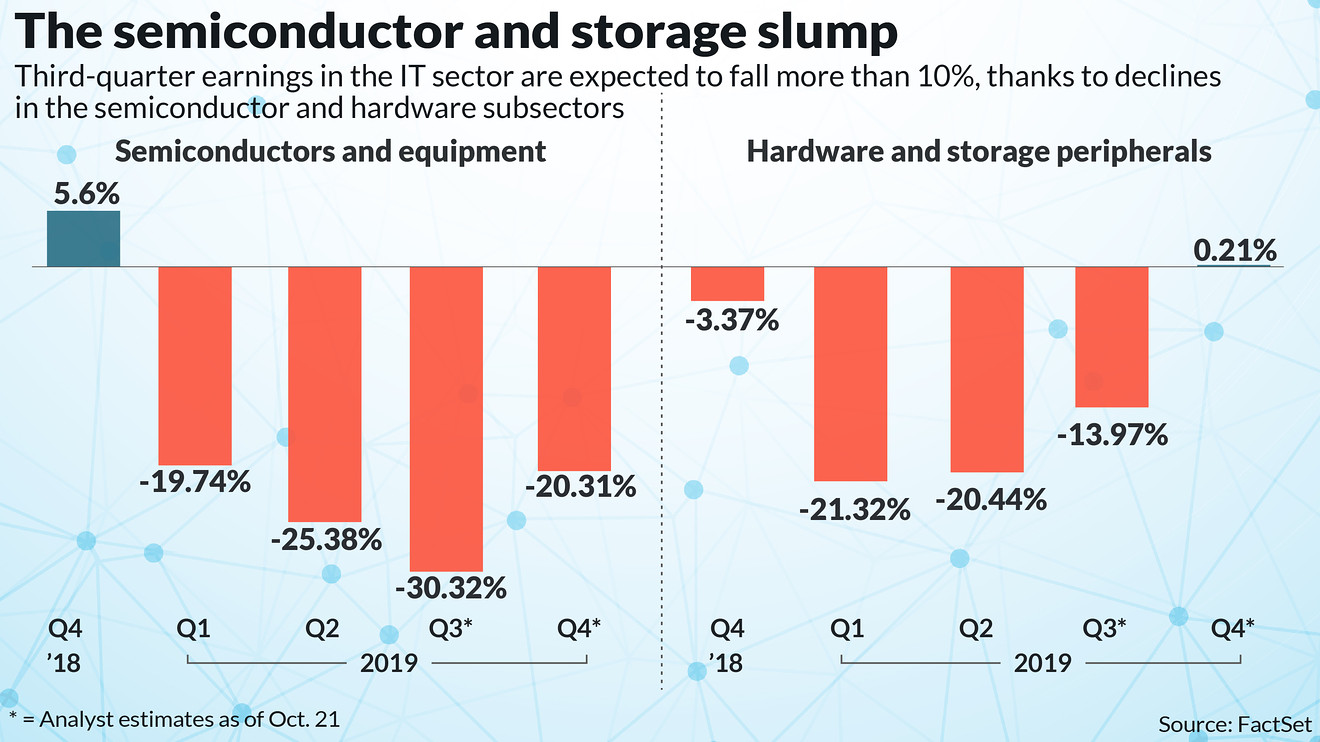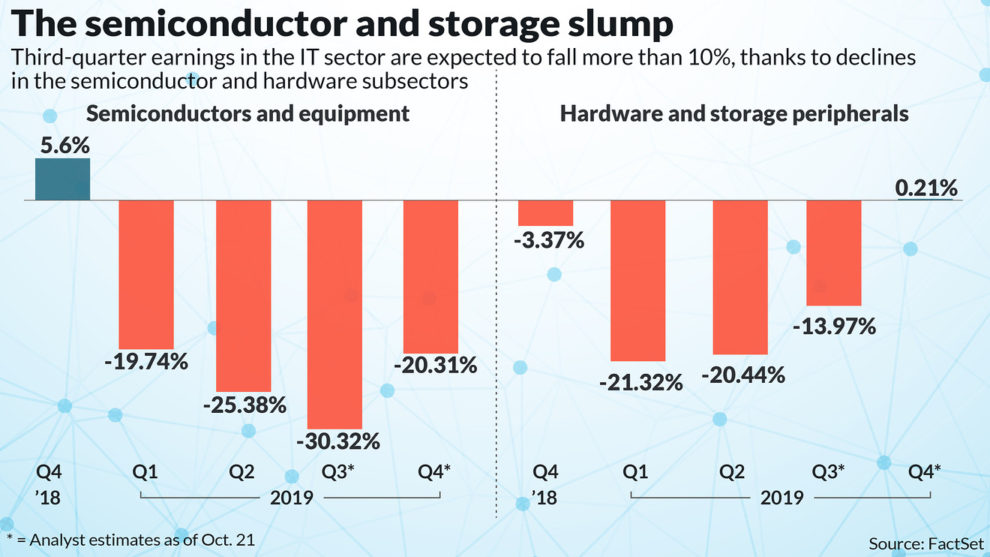
The tech sector is expected to have its worst earnings season in years, and mixed signals from the companies that make core internal components of hardware — semiconductors and storage devices — suggest that the bottom may not be near.
Reduced spending by some large data-center providers has led to a slowdown in the cloud boom, which has damaged earnings and revenue at many hardware makers this year, a trend that is expected to hit a nadir in third-quarter results. The S&P 500 index’s information-technology sector (which lost some of tech’s biggest names in a sector change last year) is expected to see earnings decline more than 10%, mostly thanks to chips and the hardware and storage sectors.
Don’t miss: We are in an earnings recession, and it is expected to get worse
Semiconductors are expected to have the worst results in all of tech, with earnings per share dropping a whopping 30% from last year’s performance and sales projected to decline 11.5%, according to a FactSet survey of analysts’ estimates that includes some reported numbers, such as last month’s downbeat results from memory-chip kingpin Micron Technology Inc. MU, +1.97% MU, +1.97% MU, +1.97% in its data.
Many analysts believe that those woeful third-quarter results reflect the bottom for the current semiconductor downturn, and companies have suggested the crunch is easing, including Micron in the season’s first big tech-earnings test. Investors seem to believe it: The Philadelphia Semiconductor Index SOX, +2.05% has jumped nearly 38% this year, despite massive earnings and revenue declines.
But semiconductor companies suggested earlier this year that they should already be rebounding by now, and we still haven’t seen it. A bounceback before the end of the year is far from a given because of the crosscurrents of a trade war with China, the PC upgrade cycle and the wait for 5G technology.
“Hopefully we are at the end of the [down] cycle, but who knows,” said Stacy Rasgon, a Bernstein Research analyst who admitted that he was amazed at the continued high valuations of the semiconductor group overall.
“There is still a lot of uncertainty,” Rasgon said last week. “The trade talks are going every which way every day.” He said he believes investors seem to have a bit of fear of missing out. “The sector is typically anticipatory,” he said, adding that investors “are afraid not to be there” when the news gets better.
See also: The five companies most at fault for the earnings recession
The news hasn’t necessarily gotten better in the early days of this earnings season. Texas Instruments Inc. TXN, +1.77% gave a very disappointing fourth-quarter forecast and executives made comments about customer concerns that led at least one analyst to question the entire sector.
“I think we can’t rule out, obviously, customers having built inventory in preparations for builds or concerns with the trade tensions, but the weakness that we saw wasn’t limited to any region, so it was very broad-based,” Dave Paul, TI’s vice president of investor relations, told analysts Tuesday. TI Chief Financial Officer Rafael Lizardi told analysts, “This thing we’ve been in, it [has been] for four quarters and it’s going to be longer than that.”
Xilinx Inc. XLNX, +1.91% was projected to be an outlier with positive growth, but gave a light forecast and blamed the ban on sales to Chinese tech giant Huawei, as well as continued data-center issues.
“We are seeing a pause in hyperscale customer orders” in the calendar fourth quarter, Xilinx Chief Executive Victor Peng told analysts, adding that he expects growth to resume in Xilinx’s fiscal fourth quarter, which will be calendar first quarter.
Intel Corp. INTC, +8.10% seemed to offer the relief that chip investors had been waiting for by showing 4% growth in its data-center business when a contraction was expected, and raising its guidance. But that surprise gain was in part due to $200 million of orders that came in for the third quarter instead of the fourth ahead of anticipated tariffs, and caused analysts to doubt that the momentum can continue. After flying higher in late trading Thursday, Intel fell back to even in regular trading Friday.
Even with the doubts, though, chip companies might be in a better position than storage vendors. That subsector, officially known as “Technology Hardware Storage and Peripherals,” is expected to fare slightly better than semiconductors, but that is largely because it includes Apple Inc. AAPL, +1.23% and HP Inc. HPQ, +1.23%.
Storage companies such as Western Digital Corp. WDC, +2.87% , Seagate Technology STX, +1.20% and NetApp Inc. NTAP, +1.01% have been slammed by cloud service providers taking a breather in their build-outs. Western Digital, for example, has seen earnings per share decline more than 90% in each of the past two quarters, and is expected to report a 90%-plus decline yet again when it reports Oct. 30. Seagate’s earnings are expected to drop about 47%.
Read more about the mixed signals memory chip makers have given about a rebound
“We felt that there would be a slowing in demand in the first half of this calendar year and then we expect the demand to increase in the second half of the calendar year,” Robert Eulau, Western Digital Chief Financial Officer, told investors at a conference last month. “And that’s effectively what’s played out and we’ve done very well from a hard-drive standpoint with the hyperscalers, really pleased with how we’re positioned there and the market share that we have.”
With less than three months left in the second half that both chip companies and storage companies have said would bring about a rebound, we still haven’t seen it. This column warned early this year that optimism about a second-half comeback for chips came with very little evidence, and so far we have still seen little to suggest a sustained recovery. Still, analysts expect the rebound to begin in the holiday season, with current projections calling for hardware earnings to move to growth in the fourth quarter while the decline in chips is expected to shrink to about 21% instead of this quarter’s 30%.
But if semiconductor and storage companies can’t hit those forecasts, and if TI and Xilinx end up being leading examples, the crosscurrents are likely going to suddenly go in the same direction: Down. And tech stocks could go right along with them.











Add Comment